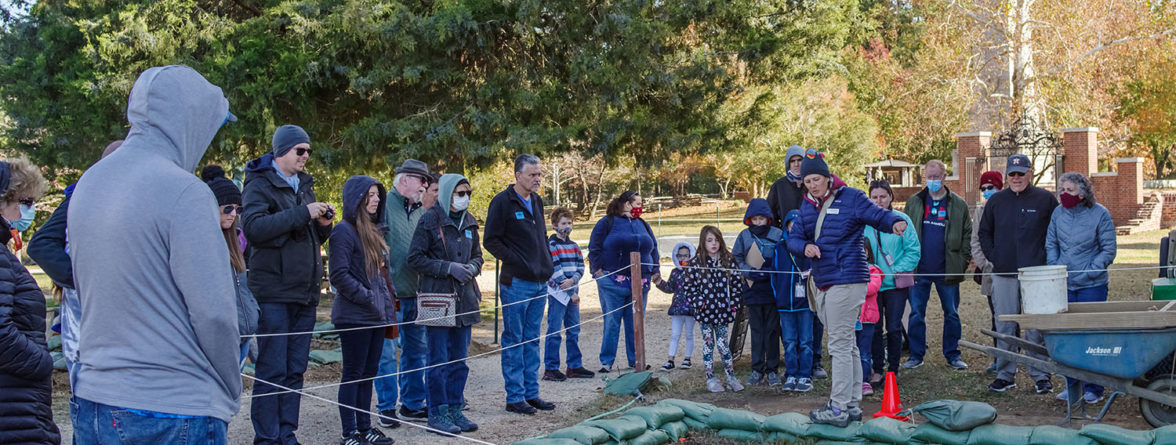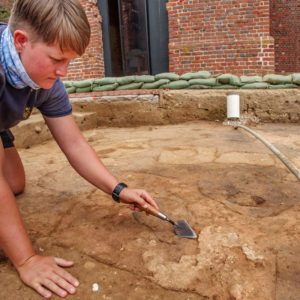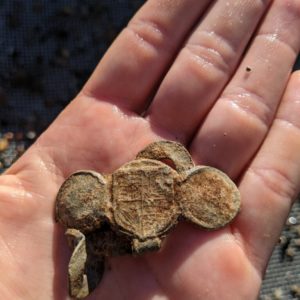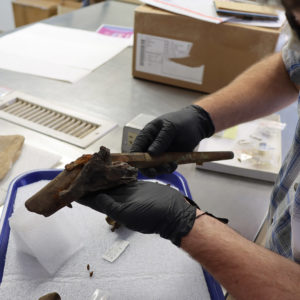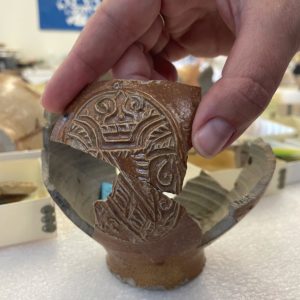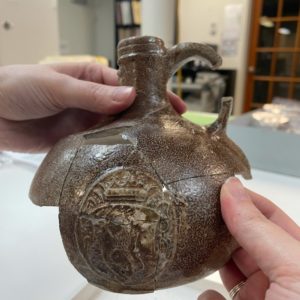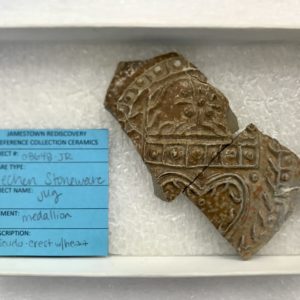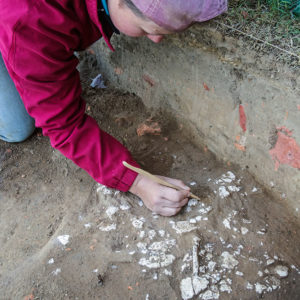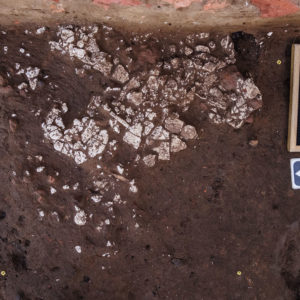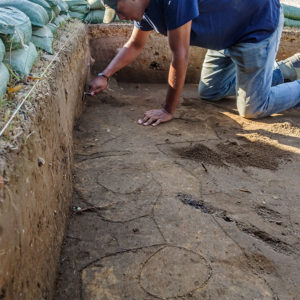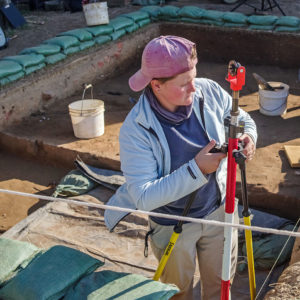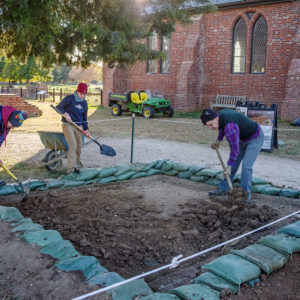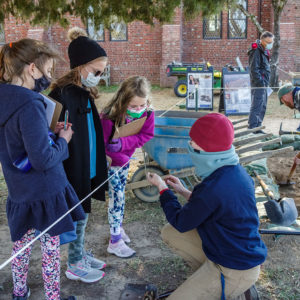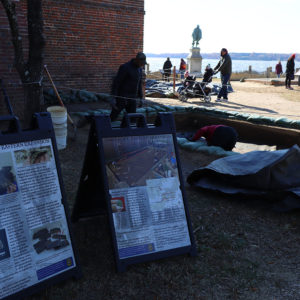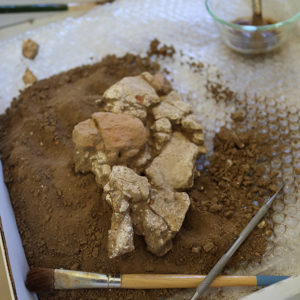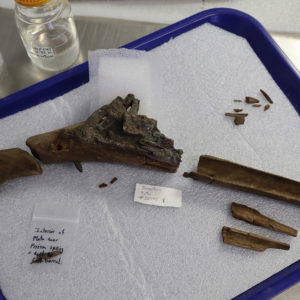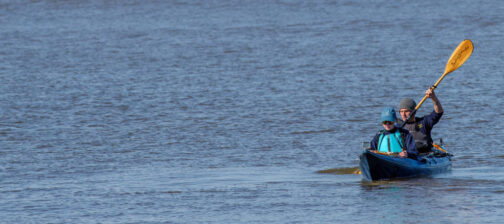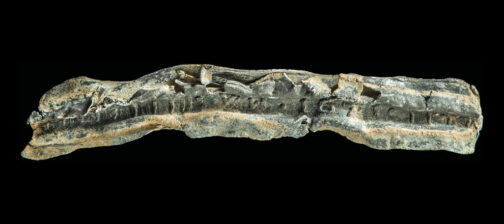The dig continues in three locations in and around James Fort, two sites near the Church Tower and one along the Seawall near the fort’s eastern bulwark. Excavations are proceeding on the west side of the Church Tower where a significant burn layer related to Bacon’s Rebellion was discovered this summer. On the north side, archaeologists continue to work on an early pit that has yielded both colonial and Virginia Indian artifacts. At the Seawall dig, remains of the eastern bulwark ditch and dozens of early artifacts continue to be discovered, including a six-part lead seal stamped with the English royal coat of arms. The collections team continues to work on the artifacts found in the field, both recent and many older ones, including some being prepared for a new exhibit in the Archaearium entitled “Gentlemen Soldiers.”
On the western and northern sides of the ca. 1680 Church Tower, the Jamestown Rediscovery archaeologists are carefully peeling away the soil, revealing 17th-century features and artifacts in the process. On the western side, Site Supervisor Anna Shackelford and her team continue to excavate a burn layer between an inch and three inches thick that was found this summer, with scorched plaster being found just above the burned soil. The layer is very likely evidence of Bacon’s Rebellion, during which on September 19, 1676 Nathaniel Bacon and his men burned Jamestown, then the colonial capital. The church’s belfry — then very likely still a wood and plaster structure — may have collapsed, the evidence for which we are seeing here. The Church Tower that exists today was built around four years later, entirely out of brick. The team will be extending the dig area in the weeks and months ahead to fully gauge the extent of the burn area.
A few yards away, on the north side of the Church Tower, plaster has also been found, but no evidence of burning. This plaster may be a discarded section of the 1617 timber framed church wall. In the 1630s and 1640s, the original timber framed building was encapsulated in brick. Near the west end of the timber frame, this brick wall turned and punched through the earlier structure. This divided the church into two parts: an eastern end that was clad in brick on the exterior, and a western end that remained solely timber framed. The east portion would have contained the main body of the church, while the west section comprised the vestry and belfry. A church in England that has a similar configuration can be found in Dormston. The dividing wall was built around 1647, and would have cut through the wood and plaster structure of the timber frame building. The plaster feature recently dug by Archaeologists Caitlin Delmas and Kalen Anderson is probably from this 1647 remodeling.
In addition to the plaster, a roof tile and a dense slag deposit were also found here. Work continues on a pit that probably dates to the 1610s where Virginia Indian ceramics and colonial brigandine armor were found earlier this year. Excavations on another section of this pit in 2006 revealed fragments of a cheese strainer similar to one that is now on exhibit in the Archaearium. On the other side of the walking path a new square is being excavated but the crew haven’t gotten very deep yet. Still, evidence of a ditch and several potential postholes have been found. It is too early to assess the function or date on these features yet. A sherd of manganese-decorated Delftware ceramic was found here recently.
At the Seawall near the eastern bulwark, the archaeologists continue to battle water from both rain and river seepage during high tide. They have uncovered additional sections of the eastern bulwark trench and artifacts continue to emerge from the midden discovered here. Bricks cutting through this midden are probably part of the property of John White, a merchant who lived here in the second quarter of the 17th century. Among the more interesting artifacts found here in the past month was a six-part lead seal, only the second six-part lead seal found here since the excavations began in 1994. Lead seals were used to mark goods — most commonly textiles — with information such as manufacturer, origin, quality and other customs-related information. The English royal coat of arms is stamped on one plate of the seal, and on another plate “LENOX.” Starting in 1605 under James I, the Dukes and Duchesses of Lennox and Richmond were the king’s official alnagers, responsible for inspecting and taxing saleable textiles.
The collections team are busy with a variety of projects inside the Rediscovery Center. In addition to conserving and cataloging the recent finds from the field, we are busy preparing artifacts for the upcoming “Gentlemen Soldiers” exhibit due to debut in the Archaearium in February. The conservation team is preparing a number of artifacts for the exhibit, including a pistol found in the fort’s second well in 2006. Conservator Chris Wilkins is in the process of conserving the barrel. The wooden portions of the pistol were conserved by our conservation team and the Mariners’ Museum through a process of polyethylene glycol immersion and vacuum freeze drying. After all the pieces are ready, Chris will assemble the fragments together for display in the exhibit. The pistol has a Roman lock firing mechanism and will be on display with other objects including a halberd found in the same well.
During recent excavations, the field archaeologists have found a few interesting Bartmann jug fragments. Fortunately, our curatorial staff is working with an intern who is focusing on the Bartmann jugs in the Jamestown collection. Amber Poole is a student at William & Mary, and her semester-long internship will provide her a few credits towards completing the NIAHD (National Institute of American History and Design) Material Culture & Public History program. She has helped us to better document our mended Bartmann jugs, and hopefully you will see some of the results of her work on the website as her internship wraps up.
Two recently excavated sherds in particular were exciting to Amber and the curatorial staff. One fragment from the midden layers at the Seawall excavation site, and one from the north Church Tower excavation site mended to vessels that are already partially complete in the collection. It is always exciting for us to find a mend, and is particularly fun when the fragment is a recent find.
The fragment found at the north Church Tower site mended to a jug that includes a medallion with the Danish coat of arms, showing a rampant lion holding an axe. The rest of the fragments of this vessel came from the first well. This cross-mend tells us that the first well and soil in the north Church Tower excavation area contained the same trash. Because the first well was no longer a good source of drinking water and was filled with trash by the spring of 1610, it is likely that the pit feature in the north Church Tower excavation area may be from the same early time period on the site. More excavation is needed to solve this mystery.
Senior Conservator Dan Gamble has been working on conserving some of the plaster found in the north Church Tower dig. He has also completed conservation of a spur buckle found in the midden of the Seawall excavations. Spur buckles were used to attach spurs to boots. This type, called butterfly-style spur buckles due to their wing-like decorative ends, were manufactured between 1620 and 1680. Dan’s expertise can be seen in the “after” portion of the artifact image showing both pre- and post-conservation photos.
related images
- Recently excavated sherd from midden layer in the Seawall area, mending to Bartmann jug with a pseudo-crest
- Bartmann jug with medallion depicting the Danish coat of arms: a rampant lion holding an axe
- Bartmann jug with one mending sherd excavated from the North Church excavation area
- Bartmann medallion fragments showing a pseudo-crest with a heart
- Caitlin Delmas excavates plaster at the north Church Tower site.
- Plaster at the north Church Tower dig site
- Archaeologist Kalen Anderson at the north Church Tower excavations
- Archaeologist Caitlin Delmas surveys the north Church Tower excavations.
- Senior Staff Archaeologist Sean Romo excavates an iron object at the north Church Tower excavations.
- Archaeologists Mary Anna Richardson, Natalie Reid, and Don Warmke begin the excavations of the new square in the north Church Tower area.
- Archaeologist Natalie Reid shares some of the latest finds with visitors.
- The dig on the north side of the Church Tower
- The pistol barrel and ramrod holder
- Plaster and brick from the Church Tower excavations
- The pistol sans barrel


